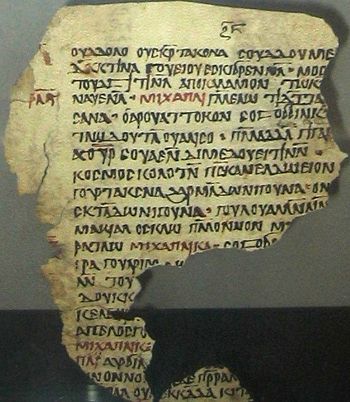Old Nubian language
2008/9 Schools Wikipedia Selection. Related subjects: Languages

Old Nubian is an ancient variety of the Nubian languages, spoken until about the 15th century AD. It is ancestral to modern-day Nobiin and other Nubian languages spoken in Nubia. It is preserved in at least a hundred pages of documents, mostly of a Christian religious nature, written using a modified form of the Coptic (Greek) script; the best known is The Martyrdom of Saint Menas. It is the oldest written sub-Saharan African language apart from Meroitic and Ge'ez.
Writing
Old Nubian is written with an uncial variety of the Greek alphabet, extended with three Coptic letters — ϣ "sh", ϩ "h", and ϭ "j" — and three unique to Nubian: ⳡ "ny" and ⳣ "w", apparently derived from Meroitic; and ⳟ "ng", thought to be a ligature of two Greek gammas. Each letter could have a line drawn above it, when it was:
- a vowel which formed a syllable by itself, or was preceded by one of l, n, r, or j;
- a consonant with an i (sometimes unwritten) preceding it.
The sound /i/ could be written ε, ̄ ει, η;, ι, or υ; /u/ was normally written ου. In diphthongs, a dieresis was sometimes used over ι to indicate the semivowel y.
Geminate consonants were written double; long vowels were usually not distinguished from short ones. Tones were not marked.
Punctuation marks included a high dot •, sometimes substituted by a double backslash \\, used roughly like an English period or colon, a slash / used like a question mark, and a double slash // sometimes used to separate verses.
Grammar
Noun
Old Nubian has no gender, nor any articles. The noun consists of a stem to which grammatical case suffixes and postpositions are added; the main ones are:
- -l nominative, marking the subject: eg diabolos-il "the devil (subj.)"; iskit-l "the earth (subj.)".
- -n(a) genitive, marking the possessor: eg iart-na palkit-la "into the sea of thoughts".
- -k(a) "directive", marking the direct or indirect object: eg Mikhaili-ka "Michael (obj.), to Michael"
- -lo locative, meaning "at"
- -la inessive, meaning "in(to)"
- -do, meaning "on"
- -dal meaning "with"
The most common plural is in -gu-; eg uru-gu-na "of kings", or gindette-gu-ka "thorns ( object)", becoming -agui- in the predicative. Rarer plurals include -rigu- (eg mug-rigu-ka "dogs (obj.)" (predicative -regui-) and -pigu-.
Pronoun
The basic pronouns are:
- ai- "I"
- ir- "you (singular)"
- tar- "he, she, it"
- er- "we (including you)"
- u- "we (excluding you)"
- ur- "you (plural)"
- ter- "they"
Demonstratives include in- "this", man- "that"; interrogatives include ngai- "who?", min- "what?", islo "where?", iskal "how?".
Verb
The verb has five main forms: present, two different preterites, future, and imperative. For each of these, there are subjunctive and indicative forms. It conjugates according to person, eg for doll- "wish" in the present tense:
- dollire "I wish"
- dollina "you (singular) wish", "he, she, it wishes"
- dolliro "we wish", "you (plural) wish"
- dollirana "they wish"
Example text
κτ̄κα γελγελο̄ϲουανον ῑη̄ϲουϲι να⋊αν τρικα• δολλε πολγαρα πεϲϲνα• παπο ϲ̄κοελμ̄με εκ̄κα
Kitka gelgelosuannon Iisusi manyan trika• dolle polgara pessna• papo iskoelimme ikka.
Literally: "Rock and-when-they-rolled-away Jesus eye pair high raising he-said father I-thank you."
Translated: "And when they rolled away the rock, Jesus, raising his eyes high, said: Father, I thank you."